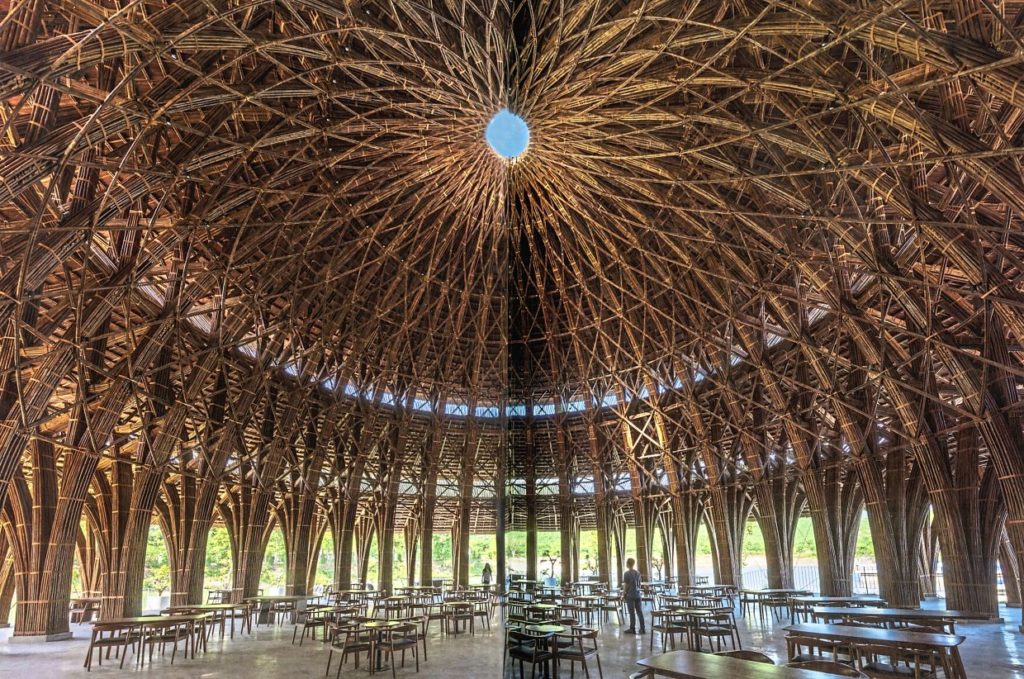Growing up, architect and bamboo advocate Low Ewe Jin remembers playing amidst bamboo clusters near his homes in Tapah, Perak, and Melaka where he lived at different times.
He would also spend his free time making things like bows and arrows, fishing poles and kites out of bamboo strips.
However, little did he realise then that those early crafting and designing experiences would later bloom into something much bigger – buildings, to be exact.
“Although I played with bamboo as a kid, my knowledge and passion in bamboo developed much later in my career during my time as lead architect at a firm in Bali (2015-2018),” said Low over a phone interview recently.
During his tenure there, he learnt about the treatment, design and construction of bamboo and how it is all intertwined in the Balinese culture and community.
“The taksu or essence of how the plant and material is respected and handled is very much embedded in the Balinese way of life,” he said.
Some of his notable projects there include designing many of the bamboo buildings in Green School Bali and Green Village Bali.
The Green School, conceived in 2006 by entrepreneurs John and Cynthia Hardy, advocates for sustainability through community-
integrated, entrepreneurial learning in a natural environment. Green Village is one of Bali’s foremost sustainable living and housing communities.
Low related how he learned to protect and work with bamboo, letting it guide building designs rather than boxing it up with conventional design and construction methods.
“With most bamboo buildings, the structure itself is the architecture, so it’s important to let bamboo take the lead in your design.
“Architects who are keen to use bamboo have to reset their approach as building with bamboo is very different from conventional building methods,” he said.
Low is the author of a new book entitled Bamboo Ark: Exemplary Bamboo Buildings, which features a collection of 30 contemporary bamboo buildings in various countries from South America to South-East Asia.
“Each of the buildings tells a story, and that is the common thread for most bamboo projects as they are still very much bespoke and fascinating in their design process, procurement and construction,” explained Low.
The buildings in the book were constructed using both traditional methods of construction as well as new and innovative techniques.
Co-written with Sandy Chew, the 280-page hardcover is Low’s first book and is published by Atelier International.
Low added that “a successful bamboo building is all about how it comes together as a process right from bamboo cultivation, sensitive harvesting, preserving and treating it adequately, to designing with care, and building it with a team or the backing of a community”.
“Bamboo has re-emerged as a contending building material in a world where we are faced head-on with climate change and environmental issues. This collection of buildings and the stories they convey will serve to inform, invoke and motivate those who are embarking or are already on the bamboo path,” said Low, in the introduction to the book.
As bamboo is a relatively new building material compared to other established ones like timber, steel and concrete, and there are limited design and technical books for bamboo, Low’s book serves as a guide and reference on bamboo architecture to further promote the use of bamboo in design and construction.
Advocacy work
Low graduated from Brighton University in England and practised in England, South-East Asia and Australia for more than 30 years before going to Bali in 2015 to join the firm Ibuku, a sustainable design and architecture firm.
“It was a big move for both my wife and I to move from Australia to Bali but we decided to go there since our kids were all grown up,” said Low.
In Bali, he also actively promoted the use of bamboo through talks and workshops for Bamboo U Bali, an educational enterprise that shares knowledge on bamboo design and sustainable architecture.
In 2018, Low decided started his own firm Tenten Design, a remote-working architectural practice consisting of collaborative professionals in Australia and the Asia Pacific region, to develop his own bamboo projects.
Then in May 2020, during the pandemic lockdown, Low – who was in Melbourne, Australia, at the time – founded Better Bamboo Buildings, an online platform for bamboo design information and insights.
Subsequently, he set up Designing Better Bamboo Buildings, a bamboo design learning resource which runs advanced bamboo design building courses and workshops.
“Bamboo is re-emerging as a sustainable, viable and versatile building material with many advantages.
“It is highly regenerative, fast-growing, lightweight and widespread. It absorbs carbon dioxide, produces oxygen, restores degraded land and also helps control erosion.
“But since it is a natural material, knowledge on how to protect and maintain it is crucial. And a lot more support, education and cooperation is needed to further establish it in the mainstream arena,” he said.
Go to betterbamboobuildings.com or Instagram for more info.





